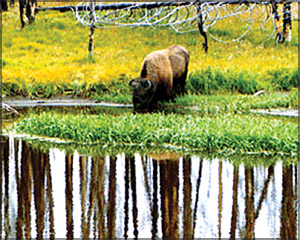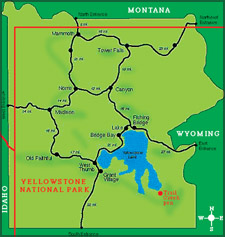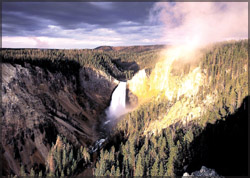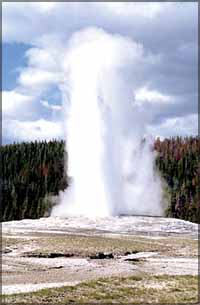|
YELLOWSTONE NATIONAL PARK
World's first park
 There
are many national parks in our country such as Yala, Wilpattu and Uda
Walawe, which are rich in both There
are many national parks in our country such as Yala, Wilpattu and Uda
Walawe, which are rich in both fauna and flora. Some of you may have visited at least one of these
national parks and admired the wildlife and natural vegetation in the
park.
fauna and flora. Some of you may have visited at least one of these
national parks and admired the wildlife and natural vegetation in the
park.
We have featured some of the local national parks in our earlier
issues. Today too, we will be focusing on yet another national park, but
not one in our motherland.
We want to take you on a tour of the world's first and also the
largest national park - the Yellowstone National Park, situated in
America. Has anyone of you ever visited this park or at least seen on
television the rich diversity of this park? Let's take a peek at what
this wonderful natural reserve has to offer.
Established on March 1, 1872, following a bill signed by US President
Ulysses S. Grant, the park spans an area of 2,219,789 acres (3,472
square miles or 8,987 km2). It spreads over three States, Wyoning (96
per cent), Montana (3 per cent) and Idaho (one per cent).
 It
also contains a part of the world's largest intact temperate zone
ecosystems, the Greater Yellowstone Eco System. The park's name is
derived from its location at the Headwaters of the Yellowstone River.
Most of the park is about 7,500 ft above sea level, experiencing
moderate summers and cold winters. It
also contains a part of the world's largest intact temperate zone
ecosystems, the Greater Yellowstone Eco System. The park's name is
derived from its location at the Headwaters of the Yellowstone River.
Most of the park is about 7,500 ft above sea level, experiencing
moderate summers and cold winters.
The park which is situated on the Yellowstone plateau is bounded on
nearly all sides by mountain ranges of the Middle Rocky Mountains. The
highest point in the park is atop Eagle Peak (11,358 ft) and the lowest
is Reese Creek (5,282 ft).
A major feature of the Yellowstone plateau is the Yellowstone Caldera
- a long area nearly filled with volcanic debris, measuring 30 by 46
miles (50x60 km). Within this area lies the largest, high elevation lake
in North America, termed super volcanic since it was formed by an
exceptionally large explosive eruption which occurred about 640,000
years ago.
The Yellowstone lake is 87,040 acres, in extent and 400 feet deep. It
has a shoreline stretching 110 miles.
Sprawling across the northwest corner of Wyoming, the park contains
more than two million acres of steaming geysers (numbering 300) including the world famous Old Faithful geyser,
crystalline lakes; thunderous waterfalls (numbering around 290), hot
springs, which includes the largest, the Grand Prismatic Spring, and
also the world famous Grand Canyon. The park has around 10,000
geothermal features which are fascinating.
geysers (numbering 300) including the world famous Old Faithful geyser,
crystalline lakes; thunderous waterfalls (numbering around 290), hot
springs, which includes the largest, the Grand Prismatic Spring, and
also the world famous Grand Canyon. The park has around 10,000
geothermal features which are fascinating.
The forest cover, which spreads over 2.2 million acres, nearly 80 per
cent of the park, has a great variety of plants and trees, some of which
cannot be found anywhere else.
The dominant tree species is the Lodgepole pine which is a tall,
straight tree about 75 ft high, but a large variety of spruce, aspen and
fir too are found here. Some of the flowers found in the park are
eyecatching.
 It
is home to wildlife such as free-ranging herds of bison and elk,
grizzleys, black bears, wolves, moose, deer and puma. More than 60
species of mammals which includes the coyote, the park's top canine
predator, and around 18 species of fish such as the cutthroat trout have
been so far recorded. It
is home to wildlife such as free-ranging herds of bison and elk,
grizzleys, black bears, wolves, moose, deer and puma. More than 60
species of mammals which includes the coyote, the park's top canine
predator, and around 18 species of fish such as the cutthroat trout have
been so far recorded.
***
Fact File
Park's history
A comprehensive report by F. V. Hayden on Yellowstone convinced the
US Congress to withdraw this region from public auction and by law
declare it a national park in 1872, Nathanial Hangford was appointed as
the park's first superintendent in 1872. He served for five years, but
he was not paid a salary.
The National Pacific Railroad built a train station at the northern
entrance in the early 1880s, which resulted in
|

Aspen trees
|
the number of visitors to the park increasing from 300 in 1882,
to 5,000 in 1883 alone. Today it is recorded that more than three
million people visit the Yellowstone National Park every year.
The poaching and destruction of the park, which happened in the early
years, stopped only after the US Army arrived at Mammoth Hot Springs and
built Camp Sheridan, which was later renamed as Fort Yellowstone.
The National Park Service (NPS) was created in 1916 and on October
31, 1918, the army turned over control to the NPS.
In 1959, a powerful earthquake, just north of Yellowstone Quake Lake,
damaged roads and some structures in the park. However, over the years,
the roads have been developed and many facilities have been introduced
for tourists, offering recreational opportunities such as sightseeing,
camping, boating, fishing and hiking.
Forest fires occur every year in the park, but the biggest so far,
which took place in 1988, destroyed nearly one-third of the park.
|

A lake
|
Designated as an International Biosphere Reserve on October 26, 1976.
It was named a UN World Heritage Site on September 8,1978.
Early geographical history
Scientists have traced Yellowstone's origin to a hot spot in the
mantle -
|

Old Faithful geyser |
one of the few dozens of such hot spots on Earth.
The current caldera on which Yellowstone is situated was created by a
cataclysmic eruption about 640,000 years ago. It was a thousand times
larger than the eruption of Mount St. Helen's in 1980. It produced a
crater nearly two thirds of a mile deep (one kilometre) and 52 by 286
miles in area.
It is recorded that three cataclysmic eruptions have taken place in
this region; one 640,000 years ago, and the
other two 2.1 million and 1.2 million years ago. All three
climax eruptions had released vast amounts of ash that blanketed much of
central North America, falling many hundreds of miles.

Castle geyser
|
The ash and the gases released had a significant impact on the
weather and also the
|

Grand Prismatic spring |
extinction of many species primal to North America.
Native Americans have lived in the Yellowstone region for at least
11,000 years. Yellowstone is located at the northeastern end of the
Snake River Plain.
Old Faithful which is the largest geyser is located in the Upper
Geyser Basin, while the Steamboat Geyser, which is the world's largest
active geyser is located in the Noris Geyser Basin.
Internet |
